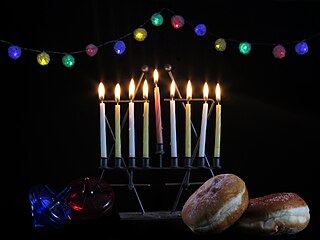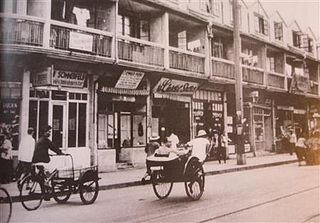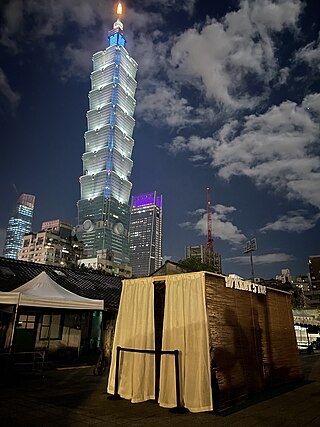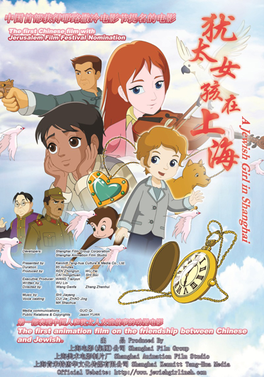Israelis in China, as compared to other foreign communities, are not large in number. There are at most a few hundred in each of a few major cities, and possibly more scattered around in other locations outside the major cities.
Roughly 130 Israelis were reported to live in Beijing in 2005. [1] In 2005, the Israeli embassy to China held their Hanukkah celebrations at the Great Wall of China, the first such celebration in Chinese history. [2]
Shanghai's Israeli community may be the largest in mainland China. In 1995, when the Israeli consulate opened, only two Israelis lived in the city. However, by 2003 that number had grown to 70, and by 2005 over 200 Israelis were registered as living in Shanghai. [3] The city also boasts an Israeli restaurant run by a husband-and-wife team from Israel who came with their three sons which is considered something of a gathering point for the city's Israeli community; the Israeli consul is also known to frequent the restaurant. [4]
Many Israelis in Shanghai are involved in the diamond industry. Most notable among them is Sara Imas, a former Chinese citizen with a German Jewish father and Jiangsu mother, who was born and raised in China and later recognized by former Israeli Prime Minister Yitzhak Rabin as the first Jewish immigrant from China to Israel. Imas later returned to Shanghai as the representative of a diamond company after gaining Israeli citizenship and living in Israel for 12 years. [5]
The Israeli community in Hong Kong is larger than those of Beijing and Shanghai combined. [1]

Hanukkah is a Jewish festival commemorating the recovery of Jerusalem and subsequent rededication of the Second Temple at the beginning of the Maccabean Revolt against the Seleucid Empire in the 2nd century BCE.

Kaifeng is a prefecture-level city in east-central Henan province, China. It is one of the Eight Ancient Capitals of China, having been the capital eight times in history, and is most known for having been the Chinese capital during the Northern Song dynasty.
Jews and Judaism in China are predominantly composed of Sephardic Jews and their descendants. Other Jewish ethnic divisions are also represented, including Ashkenazi Jews, Mizrahi Jews and a number of converts.

Sidney Shapiro was an American-born Chinese actor, lawyer, translator, and writer who lived in China from 1947 to 2014. He lived in Beijing for more than 50 years and eventually became a member of the National Committee of the Chinese People's Political Consultative Conference. He was one of very few naturalized citizens of the PRC.

The Shanghai Ghetto, formally known as the Restricted Sector for Stateless Refugees, was an area of approximately one square mile (2.6 km2) in the Hongkou district of Japanese-occupied Shanghai. The area included the community around the Ohel Moshe Synagogue. Shanghai was notable for a long period as the only place in the world that unconditionally offered refuge for Jews escaping from the Nazis. After the Japanese occupied all of Shanghai in 1941, the Japanese army forced about 23,000 of the city's Jewish refugees to be restricted or relocated to the Shanghai Ghetto from 1941 to 1945 by the Proclamation Concerning Restriction of Residence and Business of Stateless Refugees. It was one of the poorest and most crowded areas of the city. Local Jewish families and American Jewish charities aided them with shelter, food, and clothing. The Japanese authorities increasingly stepped up restrictions, surrounded the ghetto with barbed wire, and the local Chinese residents, whose living conditions were often as bad, did not leave. By 21 August 1941, the Japanese government closed Shanghai to Jewish immigration.
Chinese people in Israel comprise several separate groups, including the groups of Jews from China who have immigrated to Israel making aliyah, as well as foreign students studying in Israeli universities, businessmen, merchants, and guest workers, along with Israeli citizens of Chinese ancestry.

Bahraini Jews constitute one of the world's smallest Jewish communities, although its origins go back to late antiquity. Talmudic sources refer to ports and islands on the Persian Gulf, indicating that Jews may have already settled in this region. Arabic sources record Jews in the old capital of Bahrain, Hajar, at the time of the Islamic conquest in 630 C.E. In the 12th century, the Jewish traveler-adventurer Benjamin of Tudela mentions 500 Jews living in Qays, and 5,000 in Al-Qatîf, involved in pearl fishery. In the 19th century, there were Jewish merchants from Iraq, Persia, and India in Bahrain.

Jews were among the first settlers after Hong Kong became a British colony in 1841. The first Jews arrived in Hong Kong from various parts of the British Empire as merchants and colonial officials. Among the first wave, the Baghdadi Jews stood out especially, including representatives of the influential families of Sassoon and Kadoorie. The construction of the Ohel Leah Synagogue in 1901 marked the beginning of a fully fledged religious life for the city's local Jews.

Jewish history in the territory of modern Saudi Arabia begins in classical antiquity.

Jews in Taiwan, also known as Taiwanese Jews, comprise the Jewish community residing in Taiwan, a country located in East Asia. While the Jewish population in Taiwan is relatively small compared to other communities around the world, it has a rich and diverse history that spans several decades. The first sizable presence began in the 1950s, when religious services were held in the United States military chapel, to which civilians also had access.

Moishe House is an international non-profit organization and Jewish outreach initiative. It is made up of a collection of homes throughout the world that serve as hubs for young adult Jewish community founded by David Cygielman. It provides a rent subsidy and program budget to residents who then use their home to create Jewish communal space. It is pluralistic and open to Jews of all backgrounds and affiliations.
Israeli Americans are Americans who are of full or partial Israeli descent. In this category are those who are Israelis through nationality and/or citizenship. Reflecting Israel's demographics, while the vast majority of the Israeli American populace is Jewish, it is also made up of various ethnic and religious minorities; most notably the ethnic Arab minority, which includes Christians, Druzes, and Muslims, as well as the smaller non-Arab minority ethnic groups.

Igbo Jews are members of the Igbo people of Nigeria who practice Judaism. It is a tenet of their beliefs that they have ties to one of the lost tribes of Israel, the tribe of Gad.

A public menorah is a large menorah displayed publicly during the Jewish holiday of Hanukkah. It is done to celebrate the holiday and publicize the miracle of Hanukkah, and is typically accompanied by a public event during one of the nights of Hanukkah attended by invited dignitaries who are honored with lighting the menorah.

A Jewish Girl in Shanghai is a 2010 Chinese animated family film written by Wu Lin and based on his graphic novel of the same name. It is directed by Wang Genfa and Zhang Zhenhui, and voiced by Cui Jie, Zhao Jing and Ma Shaohua.
Thanksgivukkah is a holiday name portmanteau neologism given to the convergence of the American holiday of Thanksgiving and the first day of the Jewish holiday of Hanukkah on Thursday, November 28, 2013. It was the result of a rare coincidence between the lunisolar Hebrew calendar and the Gregorian calendar. Because the calendars are not calculated the same way, Hanukkah appears from year to year on different dates on the Gregorian calendar, ranging from late November to early January.

The Shanghai Jewish Refugees Museum is a museum commemorating the Jewish refugees who lived in Shanghai during World War II after fleeing Europe to escape the Holocaust. It is located at the former Ohel Moshe or Moishe Synagogue, in the Tilanqiao Historic Area of Hongkou district, Shanghai, China. The museum features documents, photographs, films, and personal items documenting the lives of some of the more than 20,000 Jewish residents of the Restricted Sector for Stateless Refugees, better known as the Shanghai Ghetto, during the Japanese occupation of Shanghai.

The Jewish-American patronage of Chinese restaurants became prominent in the 20th century, especially among Jewish New Yorkers. It has received attention as a paradoxical form of assimilation by embracing an unfamiliar cuisine that eased the consumption of non-kosher foods.
Throughout the history of Christianity, Jewish peoples have been historically religious minorities in countries that were majority or even officially Christian. Over time, a unique relationship evolved between the Jews and the major Christian holiday of Christmas, including the creation of separate traditions and the intersection of Hanukkah and Christmas, among other convergences. Some practices perpetuate out of a feeling of otherness, while others are merely lighthearted activities that are accessible when shops are closed around Christmastime.
Antisemitism in the People's Republic of China is a mostly 21st century phenomenon and is complicated by the fact that there is little ground for antisemitism in China in historical sources. In the 2020s, antisemitic conspiracy theories in China began to spread and intensify. Some Chinese people believe in antisemitic tropes that Jews secretly rule the world.